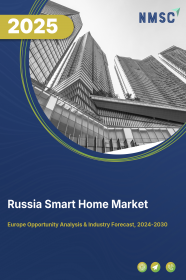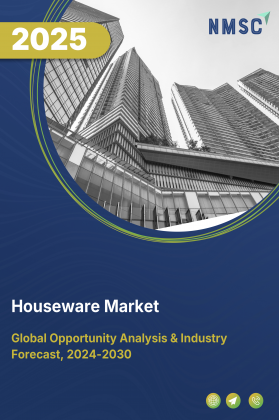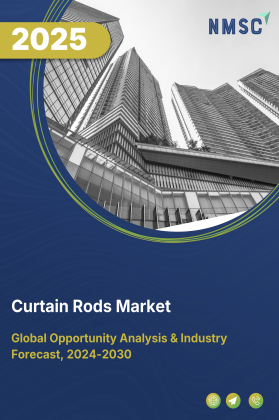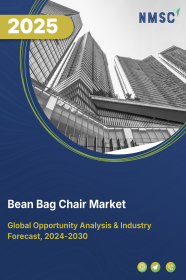
Norway Smart Home Market by Product Type (Smart Lighting, Smart Home Security and Surveillance, Smart Entertainment, and Smart Appliances), by Communication Protocol (Wifi, Zigbee, Z-wave, Bluetooth, and Thread), by Smart Home Hubs (Standalone Hubs, and Built-in Hubs), by Voice Assistants Integration (Amazon Alexa, Goggle Assistant, Apple Siri, and Others), by Smart Home Compatibility with Smartphones (iOS, and Android), and Others – Opportunity Analysis and Industry Forecast, 2024–2030
Industry: Retail and Consumer | Publish Date: 03-Sep-2025 | No of Pages: 112 | No. of Tables: 142 | No. of Figures: 87 | Format: PDF | Report Code : RC2286
Market Overview
The Russia Smart Home Market size was valued at USD 5.12 billion in 2023, and is predicted to reach USD 17.44 billion by 2030, at a CAGR of 19.1% from 2024 to 2030. A smart home, also referred to as a connected home, is a type of dwelling equipped with advanced technology and automation systems. These home automation systems enable homeowners to control and monitor various household devices, appliances, and security features through a centralized network.
These smart devices are capable of being managed remotely and often respond to voice commands or predetermined schedules, which enhances convenience, energy efficiency, and security for homeowners. Typical components found in connected homes include smart thermostats, lighting systems, security cameras, voice assistants, and other interconnected devices, all designed to enhance the overall living experience.
Strategic Government Push Toward Urban Digitalization
The Russian government is playing a proactive role in shaping the future of residential living through digital transformation. Nationwide initiatives aimed at developing smart cities and modernizing public infrastructure are directly accelerating smart home adoption. Through policy frameworks that support digital housing infrastructure—such as integrated surveillance systems, smart metering, and centralized automation—the state is setting benchmarks for energy efficiency and resident safety. These measures are encouraging both developers and homeowners to prioritize smart technologies, embedding them into Russia’s urban planning fabric.
Expanding Domestic Tech Ecosystem and Localization of Smart Solutions
Russia’s robust tech ecosystem, driven by a mix of homegrown innovators and international collaborations, is rapidly enhancing the smart home experience. A growing number of local developers are offering solutions tailored to the unique preferences and living conditions of Russian households—from voice-controlled assistants with native language capabilities to region-specific automation systems. This increasing localization, supported by high-speed internet availability and an expanding IoT infrastructure, is creating a more intuitive and relevant experience for users. As a result, the smart home concept is transitioning from a novelty to a mainstream lifestyle upgrade across Russia’s residential sectors.
Heightened Cybersecurity Concerns and Regulatory Complexities
The growing interconnectivity of home devices in Russia has raised substantial concerns around data security and system vulnerabilities. Many consumers remain hesitant to adopt smart technologies due to potential risks involving unauthorized access, surveillance, or personal data leaks. With sophisticated cyber threats on the rise and regulations around data localization and device compliance evolving, manufacturers must navigate a complex security landscape. This risk perception—especially among older populations and high-net-worth homeowners—is a key restraint on market penetration, often delaying the integration of smart home ecosystems.
Rise of Blockchain for Enhanced Smart Home Security and Automation
Blockchain technology is emerging as a game-changing enabler within the Russian smart home sector. With its decentralized, immutable nature, blockchain holds the potential to resolve many of the trust and security issues that currently limit adoption. Applications such as secure device-to-device communication, identity verification, and smart contract-driven automation are being actively explored by local tech firms. As consumer awareness grows and pilot projects prove their viability, blockchain integration is expected to accelerate, offering Russian households a new layer of control, transparency, and resilience in managing their connected environments.
Competitive Landscape
Several market players operating in the Russia smart home industry include Apple, ABB, Hitachi, Ltd, Legrand Group (Netatmo), Samsung, Xiaomi Corporation, SMEG S.p.A, Robert Bosch Smart Home, Amazon, Signify N.V. (Philips Hue), LG Electronics, Control4, Emerson Electric Co, D-Link (mydlink), Google.
Russia Smart Home Market Key Segments
By Product Type
-
Smart Lighting
-
Smart Bulbs
-
Smart Light Strips
-
Smart Switches
-
-
Smart Home Security and Surveillance
-
Smart Cameras
-
Video Doorbells
-
Smart Locks
-
Security System
-
-
Smart Entertainment
-
Smart TVs
-
Smart Speakers
-
Streaming Devices
-
-
Smart Appliances
-
Smart Refrigerators
-
Smart Ovens
-
Smart Washing Machines
-
Smart Dishwashers
-
Smart Home HVAC Management
-
Smart Rice Cooker
-
Smart Pantry/Storage System
-
Smart Blender
-
Other Smart Appliances
-
By Communication Protocol
-
Wi-Fi
-
Zigbee
-
Z-wave
-
Bluetooth
-
Thread
By Smart Home Hubs
-
Standalone Hubs
-
Built-in Hubs
By Voice Assistants Integration
-
Amazon Alexa
-
Google Assistant
-
Apple Siri
-
Others
By Smart Home Compatibility with Smartphones
-
iOS
-
Android
By Installation
-
DIY Installation
-
Professional Installation
By Sales Channel
-
Online
-
E-Commerce Platforms
-
Company Websites
-
-
Offline
-
Retail Stores
-
Supermarkets & Hypermarkets
-
Specialty Stores
-
Key Players
-
Apple
-
ABB
-
Hitachi, Ltd
-
Legrand Group (Netatmo)
-
Samsung
-
Xiaomi Corporation
-
SMEG S.p.A.
-
Robert Bosch Smart Home
-
Amazon
-
Signify N.V. (Philips Hue)
-
LG Electronics
-
Control4
-
Emerson Electric Co
-
D-Link (mydlink)
-
Google
REPORT SCOPE AND SEGMENTATION:
|
Parameters |
Details |
|
Market Size in 2023 |
USD 5.12 Billion |
|
Revenue Forecast in 2030 |
USD 17.44 Billion |
|
Growth Rate |
CAGR of 19.1% from 2024 to 2030 |
|
Analysis Period |
2023–2030 |
|
Base Year Considered |
2023 |
|
Forecast Period |
2024–2030 |
|
Market Size Estimation |
Billion (USD) |
|
Growth Factors |
|
|
Companies Profiled |
15 |
|
Market Share |
Available for 10 companies |
|
Customization Scope |
Free customization (equivalent up to 80 working hours of analysts) after purchase. Addition or alteration to country, regional, and segment scope. |
|
Pricing and Purchase Options |
Avail customized purchase options to meet your exact research needs. |

















 Speak to Our Analyst
Speak to Our Analyst
























